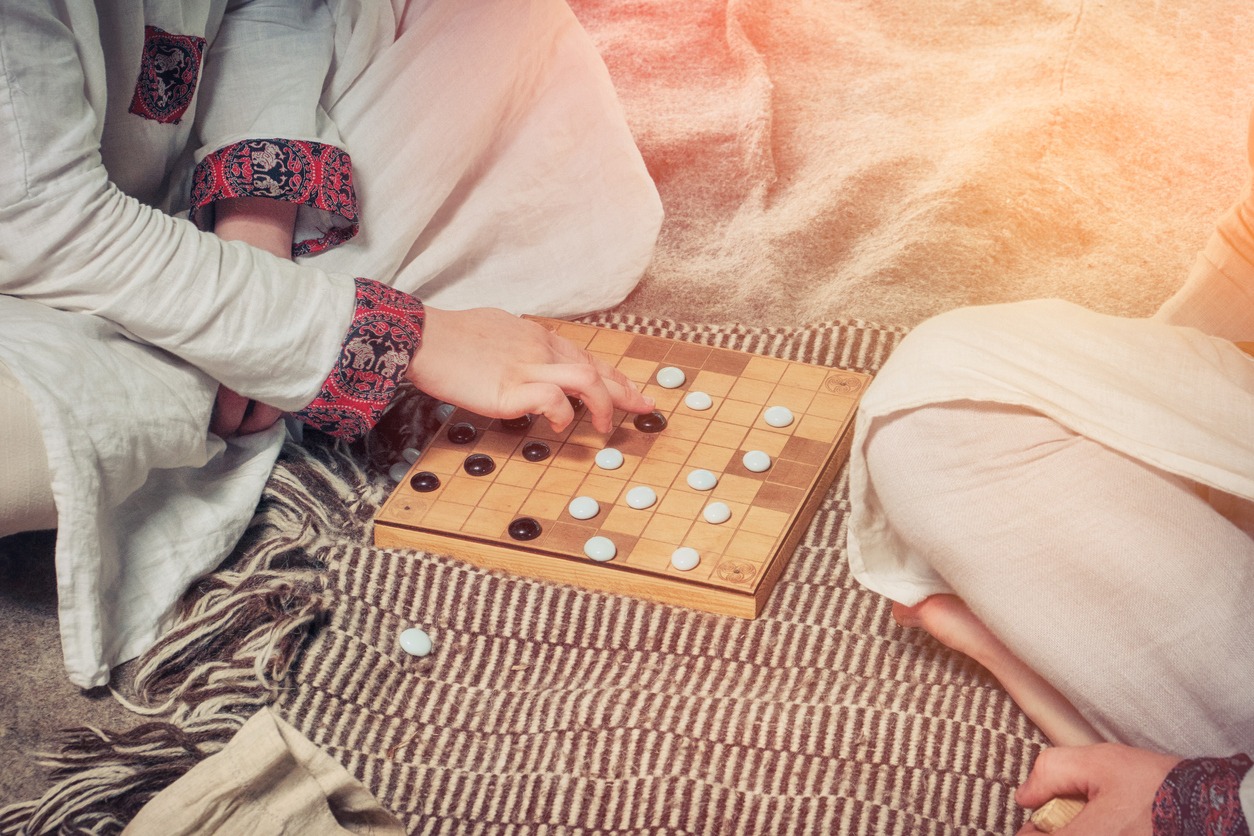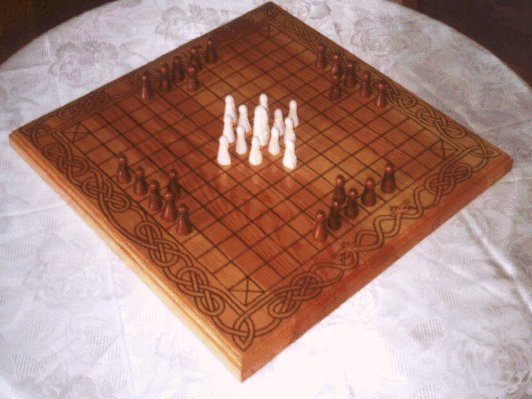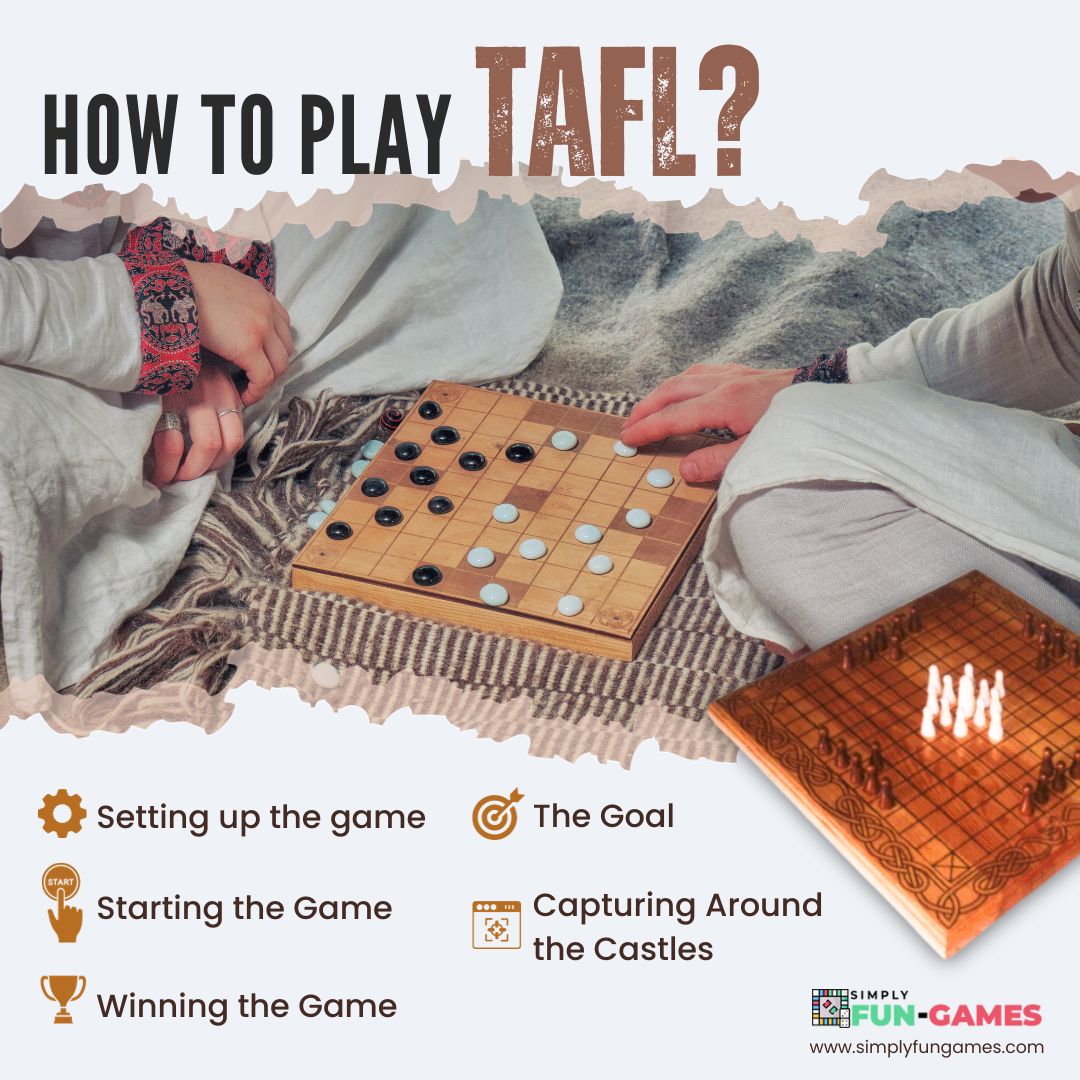Introduction
Whether you enjoy history or board games or are just looking for a new intellectual game to stimulate your mind, exploring the world of Tafl games promises to be a fascinating journey of discovery. The captivating world of Tafl games, is a traditional board game with a strategic component that has fascinated players for centuries. Since their Viking-era Scandinavian origins, these games have developed into a broad family of tactical difficulties, including different rules, board sizes, and gaming dynamics. Tafl games, often known as Viking chess, offer an immersive historical and cultural experience and fun and clever gameplay. Read on and explore the Tafl games to learn about their fascinating histories, challenging tactics, and enduring appeal.
What is Tafl Game?
Tafl, often called Hnefatafl and occasionally called “Viking chess or the King’s Table,” was a popular strategic game among Celtic and Nordic peoples in the Middle Ages and deeply ingrained in Viking culture. It is considered one of the earliest board games invented in Northern Europe, around 400 AD. The fact that the game’s rules were discovered by botanist and naturalist Carl Linnaeus is one of the game’s most intriguing and little-known features. The asymmetrical nature of Tafl’s gameplay sets it apart from other strategy games. One player controls the Viking raiding party, while the other oversees the village’s defense. The defenders are merely attempting to flee with their ruler still alive, as twice as many Vikings attempt to overpower them and kill their King.
Tafl games can be described as existing “on the edge” in at least two contexts. First, geographically: Tafl games, in all their varieties, are found on the northwestern edge of the European continent, having been transmitted by cultural transmission since the Viking age. Secondly, conceptually: Tafl games are on the edge of understanding. Due in part to misunderstandings resulting from an entry in the diary of the Swedish botanist Carl Linnaeus, discussions of how to maintain or restore game balance in tafl games have been a hallmark of ludological literature for a long time. Some academics have hypothesized that dice were used in the Welsh game tawlbwrdd, which means throw-board. While the Old English term for board games, tafl, was a general term that might apply to a die, a game played with dice, or any game of chance, just like the Latin alea.
Tafl games are distinguished by the asymmetrical (2:1) distribution of attacking and defending pieces. The defending player’s pieces are typically positioned in a defensive cluster around a king piece in the middle of a square board. The offensive player has two times as many pieces as the defensive player. The attacking pieces are positioned on each of the board’s four sides. The number of pieces and the size of the board might vary depending on the variation of Tafl being played.
The History of Tafl
Two teams of varying strength compete in the Tafl game family, an old Germanic and Celtic checkered or latticed board game. Different variants of Tafl were played over most of Northern Europe From at least 400 CE until Chess replaced it in the 12th century. The game was one of the three major international board games of the Middle Ages, together with Backgammon and Chess.
Chess replaced the 1,000-year-old Viking board game Hnefatafl, also known as Tafl. Before the advent of Chess, it was the most popular board game in Northern Europe for hundreds of years. Pieces of evidence on the existence of Tafl as early as the reign of the Vikings were found when an ancient grave from the ninth century at Birka, Sweden, on an island in Lake Mälaren, called the ultimate Viking warrior grave, was excavated. Archaeologists discovered a bag of dice and bone-carved game pieces in this grave on the Viking’s lap. Next to the body was a hnefatafl board, which used to be a traditional Viking game.
Further research of the warrior’s remains revealed that, while initially thought to be a “high-status male,” it was later revealed through DNA analysis that it was biologically female. Historians believed that the Viking wasn’t just a hobbyist but a military commander and was called the shield maiden’s grave. The Hnetafl board and carved pieces are considered one of the valuable belongings of the Vikings; at that time, it was very common practice to bury high-ranking members of the elite class with priceless items across a variety of ancient and medieval societies. Game boards and playing pieces carved from walrus tusks, bone, wood, stone, or imported glass have been found in many graves of high-status men and women throughout the Viking world.
Furthermore, at the Salme ship burial off the coast of Estonia, a Viking leader was buried together with 40 battle-fallen warriors. The Viking leader was found holding a king game piece in his mouth to represent his dynastic status. Moreover, the beautiful ivory chess-like pieces discovered near a beach in Scotland’s Hebrides are the most compelling piece of tangible evidence supporting the Vikings’ love of gaming. In Scotland, this area has long served as a Viking stronghold. In 1831, 92 ivory game pieces, including 78 unique and hand-carved chessmen, were accidentally discovered on the Isle of Lewis. The monarch or chieftain who acquired so many pieces of finely crafted walrus tusk ivory would have considered them to be a priceless asset. Because they provide so many hints about that era’s culture, they are also a treasure to the present generation.
The foundation of Viking culture was self-empowerment, frequently achieved by cunning strategies and physical prowess. When feasible, according to a thorough examination of Viking military history, they avoided engaging in strength-on-strength combat. Instead, they outwitted and outmaneuvered their military opponents by employing feints, stratagems, and mobility. It was crucial to develop these abilities and transmit them to future generations. The Vikings were masters at spinning stories, using strategy-based games to defeat opponents. Various games are depicted in the literary and archaeological archives, and Henefatafl has at least substantially survived in reconstructed form.
A more unexpected feature of this game significantly opened the door to its discovery and understanding. It lies beyond the archaeological evidence and meanings. The rules have become clear to understand thanks to the essential work done by the renowned Swedish botanist Carl von Linné (often known as Charles Linnaeus). During his study journey, Linnaeus meets the Lapp people and learns about their love of a board game they call tablut. Linnaeus observed multiple games to understand the game’s rules and determine the goal, the permitted movements, and how to win the game.
As explained by Linnaeus in his book, A Tour in Lapland, two players control two black-and-white forces positioned around a king on a board with a central square and a checkerboard pattern. One force protects the King’s position while the other attacks it. The board’s size and the number of pieces on each side may vary depending on the variation of the game. The main goal defending side of the game is to make the king escape by abandoning the board, which controls the King, while the attacking side’s goal is to capture the King. All the pieces, including the King, can move vertically and horizontally like chess rooks.
With the end of the Viking Age and the spread of Christianity, Tafl’s popularity has wavered due to changes in cultural influences and the appearance of other board games like Chess. However, Tafl was still played in some areas, especially in rural Scandinavian areas where the game’s heritage endured. Tafl has seen a resurgence in contemporary times because of archeological finds, historical studies, and the expanding interest in Viking culture. The game has been recreated and modified by modern enthusiasts using historical narratives and archeological findings as a basis. Players can now experience Tafl’s strategic difficulties and historical background thanks to the various versions and rule sets that have arisen.
Different Variations of Tafl
Tafl includes a variety of the tafl family of games, reflecting both the connection between these games and Germanic societies and the Germanic roots of the English language. Here are the variations of Tafl games that have been historically recorded or recreated using archaeological findings and historical documents.
- Hnefatafl – Vikings valued hnefatafl skill. In the game of Hnefatafl, one team defends a king in the middle of the board. The “Vikings” adversary has a larger army and attacks from the board’s four edges. At the same time, the playing pieces represent the King’s encircling defenses. The King’s objective is to flee to one of the four corners, while the Vikings’ objective is to capture the King. The Norse Sagas refer to the game Hnefatafl, which according to archaeological and literary data, possibly that Hnefatafl was played on a 13×13 or an 11×11 board.
- Alea evangelii – This game is called the game of the gospels, played on the intersections of an 18×18 cell board. Although the document refers to the board’s design as a religious allegory, it is obvious that this game was based on Hnefatafl. This 19×19 go-ban-style board tafl game is the only one we know—or at least that many people claim—to have its origins in Anglo-Saxon England.
- Bran dubh – The Irish game of Brandub, also known as Bran dubh, was played with five men versus eight, one of them was the “Branán,” or chief. Numerous 7×7 boards have been discovered, the most renowned being the complex wooden board discovered in Ballinderry in 1932. This board had peg holes for the game’s components, probably to enable mobility. Brandub means “black raven” in Arabic.
- Tawlbwrdd – Tawlbwrdd was originally played in Wales, with 16 pieces on the side of the attacker and eight pieces on the side of the King. Robert ap Ifan described the gameplay of the variants with a sketch in a text from 1587. His version had an 11 by 11 board with 24 pieces on the other team’s side and 12 on the King’s side. A king should be placed in the center of the board, twelve men should stand next to him, and twenty-four men should try to capture him. Six of each are positioned in the middle of the board’s two sides and the six central spots.
- Tablut – This variant is from Lapland and probably has the most documentation. This variant was discovered by Carolus Linnaeus in 1732 in his study about botany in Lapland. To explain the gameplay of the game, he drew a picture of the board and noted the rules in his journal. He was unable to communicate in the language and was forced to describe the game by watching the players. He noted that the game uses a 9×9 squares board in his journal.
- Fidchell – Hnefatafl’s rules are quite like those of the well-known “Celtic chess” game Fidchell. This Irish game is based on a myth that claims Lugh the Ildána, a Celtic deity of light and inspiration, created it in the ninth century.
Additionally, Fidchell may go by the names Fidhcheall, Fidceall, Fitchneal, Fithchill, or Gwyddbwyll. At the National Museum of Ireland, an original artifact of the playing board shown here is currently on display.
How to Play Tafl?
The goal of Tafl, an old strategic game played on a square board, differs depending on which version is being played. Despite variations in board size and piece count, all games included a recognizable 2:1 piece ratio, with the defending side having a king-piece that began at the center. Although there is no clear description of the rules of a tafl game, the King’s goal was to escape to the board’s edges or corners, while the bigger force’s or the attackers’ goal was to catch the King. Each game begins with the attacking army having a natural advantage, which perhaps represents an important cultural factor by simulating the success of Viking invasions. Here is a quick guide on how to play Tafl:
- Setting up the game – Depending on the game version being played, the game is played On a 9×9 or 11×11, or 7×7 board. The eight defenders, which may also vary depending on the game’s edition, begin on the eight squares that are adjacent to the King and form a cross. The King begins on the central square or castle, also known as the throne. At the center of each board edge, the sixteen or 12 attackers, in other versions, begin in groups of four. In the first variation, one player chooses 24 beads of their preferred color. These beads are the attackers’ beads, and they set six beads outside the edge, as indicated on the board. One player chooses 12 in the color beads of their choice. These beads serve as the defenders and are arranged around the throne as indicated on the board. Additionally, the defense chooses 1 bead of a different color to serve as their King bead, which is then set on the throne. The attacker moves first.
- The Goal – If you are on the defending team, the goal of the game is to have the King escape to one of the fields at the board’s edge, or if you are on the attacking team, your goal is to capture the King.
- Starting the Game – Every player takes turns to move a bead either horizontally or vertically into a free spot. The bead can make any number of straight-line movements through an unoccupied spot. The King bead can take part in captures and is played similarly to all other beads. When an opponent’s bead is situated between two other beads, either horizontally or vertically, a player may capture that bead. When an opponent’s bead is between a player’s bead and a corner square or between a player’s bead and the throne, the player can capture the opponent’s bead. Only after the King bead is surrounded on all four sides by the attackers’ bead can it be taken. The beads that are captured are taken off the board.
- Capturing Around the Castles – The castle is open to all soldiers, both attackers and defenders when the king bead is not there. This means that putting an enemy soldier between one of one’s pieces and the castle will allow for capture. If the King is in a square next to the castle, his opponents must surround him on the other three sides to capture him. Suppose the King is inside the castle surrounded by attackers on three sides but is protected by a defender on the fourth. In that case, capturing the remaining defender by pinning it between an attacker piece and the occupied castle is possible. This circumstance is the only one in which the attackers can capture a castle defender. Since the King will then participate in the capture, the defenders may be able to stop an attacker between one of their castles and the one occupied.
- Winning the Game – A player must block their opponent to prevent them from moving to win the game. The attacker wins by encircling the King bead on all four sides and capturing every defending bead. They win if the defense can get the King bead into one of the four corners. The game is deemed a draw if capture is made after 50 moves.
Conclusion
The historical board game Tafl, which dates back to the Viking Age, is a fascinating exercise in strategy and skill. The game played on a square board, matches defenders against attackers, each with a different goal. While the attackers try to encircle and capture the King, the defenders try to move them to safety at the board’s edge. Tafl’s tactical difficulties and immersive gameplay are unique in each game variation because each version has its distinct deep historical importance and cultural differences. Tafl is still a game that transcends time and represents the skill of strategic thinking, whether one is drawn to it because of its historical significance or because it stimulates the mind. However, Chess has replaced it in modern times, and it is still played in some old Scandinavian places.


